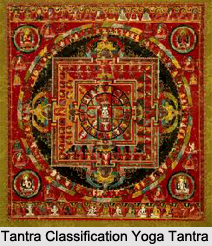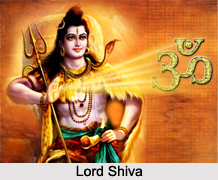 Classification of Tantra is not like watertight compartments thereby giving it certain flexibility. Tantrism denotes three classes of works - Samhita, Agama and Tantra of the Vaishnavas, Shaivas and Shaktas correspondingly. Samhita, Agama and Tantra mean collection, tradition and a set of doctrines or a book respectively. The terms do not divide the three into firm sections. For instance the Vaishnava Padma-samhita is also called Padtnatantra. Panchratra-agama which is a Shaivite work is referred to as Panchratra-samhita. Tantric works are classified also as Agama and Nigama. The works in the form of Parvati`s questions and Siva`s answers indicates Agama. Nigama are considered as those works in which this process is inverted.
Classification of Tantra is not like watertight compartments thereby giving it certain flexibility. Tantrism denotes three classes of works - Samhita, Agama and Tantra of the Vaishnavas, Shaivas and Shaktas correspondingly. Samhita, Agama and Tantra mean collection, tradition and a set of doctrines or a book respectively. The terms do not divide the three into firm sections. For instance the Vaishnava Padma-samhita is also called Padtnatantra. Panchratra-agama which is a Shaivite work is referred to as Panchratra-samhita. Tantric works are classified also as Agama and Nigama. The works in the form of Parvati`s questions and Siva`s answers indicates Agama. Nigama are considered as those works in which this process is inverted.
Tantras are divided into two categories that is Sadagama and Asadagama that is good and bad Agamas. The work in which the worship goes along with custom is sat; the reverse is asat. Tantras are also divided into astika or Vedic and Nastika or non-Vedic. According to the power of the deity the Astika works are again divided into Shakta, Shaiva, Saura, Ganapatya and Vaishnava. Again Shakta Tantras are divided into ten classes according to the names of ten Mahavidyas.
Tantra literature is divided into Srotas, Pitha and Amriaya. Tantras are divided into Hindu and non-Hindu. The non-Hindu works comprise the works of Buddhists and the Jains. Both of them belong to the Nastika class. Tantra classification is based on the mythological ages. There is a further classification which is done in accordance with their origin from the different mouths and positions of Lord Shiva.
Another classification is that of Kalkula and Srikula. Kalkula attaches the greatest importance to the cult of Goddess Kali. The followers of this school are monist. Sakti and Brahman are identical according to them. Siva-Sakti was considered as beyond dualism. According to Srikula, Shiva is the cause of the world. The atomic elements are produced by his Sakti. The followers of this school consider Shakti as Siva`s natural vibrating power.
 Tantra is further divided into Kalimata, Hadimata and Kahadimata, mentioned in the Saktisamgama Tantra. In the Kalimata School, the theoretical doctrines use the letter KA as their sign which was popular in Gauda region or Bengal. The Hadimata School is so called as it uses HA as the symbol of Lord Siva. Tarinimata is the other name given to the third school.
Tantra is further divided into Kalimata, Hadimata and Kahadimata, mentioned in the Saktisamgama Tantra. In the Kalimata School, the theoretical doctrines use the letter KA as their sign which was popular in Gauda region or Bengal. The Hadimata School is so called as it uses HA as the symbol of Lord Siva. Tarinimata is the other name given to the third school.
The subject-matter of a Tantric work may be broadly divided as follows:
1. Jhana: This refers to knowledge that includes philosophical and metaphysical doctrines with a monotheistic tendency and seldom a monistic bias. Occultism including knowledge of the mystic powers of letters, syllables, formulae and figures are also inclusive.
2. Yoga: This refers to the control of the mind for acquiring magic powers.
3. Kriya: This contains instructions for idol making and constructing and sanctifying temples.
4. Caryd: This refers to the rules about rites, festivals and social duties. As far as worship, is concerned Tantra recognises three aspects of the deity worshipped by a devotee, that is image, mantra and the highest which alone mind can realise.




















